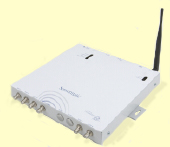Sept. 10, 2003 – ThingMagic, an engineering startup in Cambridge, Mass., has teamed up with Intel to develop a next-generation reader that delivers more computing power and is less expensive than ThingMagic’s current multi-protocol, multi-frequency reader.
“We are increasing our computing power by a factor of about 100 and reducing the cost of producing the reader,” says Bernd Schoner, a managing partner and co-founder of ThingMagic. “This is Moore’s Law in action.”
The ThingMagic Mercury4 Platform should be available later this year or early in 2004 for the U.S. market. Versions of the reader designed for Europe and Asia will follow when regulators in those regions resolve frequency issues.
The new device is essentially a Linux computer that reads RFID tags. It will feature an Intel IXP420 XScale network processor operating at 266 MHz and will come with 16MB of Flash memory and up to 64MB of DRAM. The reader will be able to support several air-interface protocols simultaneously, including EPC Class 0, EPC Class 1, ISO 15693 and ISO 18000-6.
The Auto-ID Center hired ThingMagic to develop its reader specification. ThingMagic then designed its own reader and licensed it to Tyco/Sensormatic, which manufactures the device and sells it under the SenseID Agile Reader brand.
The new reader was designed to give users more flexibility. The additional computing power enables companies to write their own software programs to run on it. The reader comes in several configurations: with four or eight ports for UHF antennas, a dual-band version with four UHF ports and two high-frequency ports, and a high-frequency version with two HF ports.
The device will also lower the total cost of ownership. In addition to an Ethernet connection, it will come with a mini-PCMCIA expansion slot that can be used to connect the reader to a WiFi (802.11) wireless network, which reduces installation costs. Software and protocol upgrades can be done remotely over the network. The device also includes a serial port, so the reader can be connected to industrial equipment, such as a photoelectric eye so it starts reading when something breaks the light beam.
ThingMagic is now working with Intel to shrink the size of the reader and to make it easier to deploy in noisy RF environments. Intel has been working with ThingMagic to tune the reader’s software so that it can more intelligently detect and respond to potential interference in RF environments. “They are lending us their expertise in this area,” says Larry Moore, VP of strategy at ThingMagic.
ThingMagic is marketing its readers in small quantities, but the company is working with licensing partners such as Tyco to mass-produce the readers. So far, Intel has not announced any plans to manufacture readers based on its collaboration with ThingMagic.
Some reader makers are focused on creating simple, low-cost “dumb” readers. ThingMagic is betting that companies will prefer intelligent readers that are easier to deploy and maintain. “The incremental cost for agility is not very high to start with and it goes to zero over time,” says Schoner. “The argument that there is a trade off in cost and functionality doesn’t hold.”
RFID Journal University
This special series of one-day courses developed by RFID Journal addresses all of the issues you need to understand before deploying RFID technologies. To view the curriculum, including complete course outlines, click here. Or visit RFID U.
|
San Francisco
|
October 7, 2003
|
|
|
New York City
|
October 21,2003 |
|
|
Atlanta
|
November 3, 2003
|
|
|
Chicago
|
November 17, 2003
|
|


